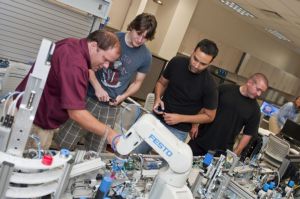

This year the National Center for Supply Chain Technology Education (SCTE) launched a strategy to address the shortage of technicians qualified to work in automated warehouses and distribution centers.
SCTE is convening Industry-Educator Workforce Forums to introduce two-year college educators to the career opportunities within automated warehouses and for the educators to meet with representatives of the nation's largest retail and shipping companies.
EMSI, a private labor market data provider, estimates that supply-chain, technician-related employment across the United States will grow by 9.1% with more than one million new jobs created between 2015 and 2025.
SCTE has further analyzed labor market data for its State Labor Market Data Briefs that provide detailed information about the expected job growth in the 19 states with the busiest and biggest supply chain "centroids" of mammoth warehouses near major airports and highways.
This year at forums in Columbus, Dallas, and Chicago, SCTE personnel shared their breakdown of supply chain workforce projections and maps that overlay the location of warehouses larger than 250,000 square feet with the location of two-year colleges.
At the Chicago meeting, for instance, SCTE's map showed 12 community colleges within a 40-mile radius of 197 distribution centers, 39 proposed centers, and seven centers under construction.
"We want to work with partners in the right spaces," Steve Harrington, SCTE industry liaison, said during a presentation at the High Impact Technology Exchange Conference (HI-TEC) in Pittsburgh in July.
Speaking along with Harrington at HI-TEC were Phil Jones, director for Engineering and Facilities at Target Corporation, and Amy Black, who leads Material Handling Maintenance Manager Support for FedEx. Jones and Black explained their companies' involvement in the collaboration that SCTE started using support from its Advanced Technological Education (ATE) grant from the National Science Foundation. SCTE is located at Norco College in Norco, California.
The Power of Collective Convening
"The power comes from the collective convening that occurs by bringing all these people together—in some cases competitors have become friends, and that would not have happened years ago—but we share a common purpose," Jones said. He said the "significant problem" of an insufficient talent pipeline is affecting where companies build new distribution facilities.
"In the modern supply chain you are measuring things in minutes now. Where it used to be days and weeks, now it's measured in minutes ... which means these facilities need to work like a clock in order to go ahead and keep product moving. We have had to turn to automated systems to go ahead and get that kind of speed," he said.
SCTE staff members hope that the Industry-Educator Workforce Forums lead to the development of "ecosystems" of collaborating industries and two-year colleges that add programs for educating people to maintain, support, operate, install, or upgrade the automated equipment and systems that support the supply chain. Supply-chain technicians' tasks may involve data management, materials handling equipment, industrial maintenance, electronics, or communications.
Data Clarify Supply Chain Technician Career Opportunities
Until SCTE's forums, the supply chain workforce demand was largely invisible because each company may need to hire only three or four technicians per year per location. Even mammoth warehouses can run 24 hours a day with just a few dozen people. Companies have been making do by hiring technicians away from each other or running shorthanded. Jones said, "We tend to steal from each other a lot, which is not sustainable."
This old way of doing business is no longer viable because e-commerce is delivering more goods in small quantities directly to consumers rather than by the pallet load to brick-and-mortar retail stores. The expansion of automated warehouse to meet individual consumers' orders coincides with large numbers of experienced technicians reaching retirement age.
Jones praised SCTE for striving to break the "scarcity paradigm" with the new strategy of introducing two-year college educators, who typically lead mechatronics or industrial maintenance programs, to the industry people responsible for distribution centers.
After developing a model program of study and an e-textbook with industry, SCTE gathered a variety of data to facilitate the development of supply-chain technology programs in key locations.
Forums Connect Industry with Educators
Armed with these data Harrington and others at SCTE set about persuading shipping companies and e-retailers to collaborate and help make the case for colleges to start supply-chain technician education programs.
Each of the forums has been convened at a huge, modern warehouse. This has given college personnel the chance to see how the facilities operate and to understand what supply-chain technicians do to keep equipment running. By offering campus tours as part of these meetings, industry personnel learn how two-year colleges can prepare technicians with the skills they need.
"There's a lot that goes into these jobs ... We have to maintain conveyor systems, we have to maintain the heating and cooling system. Things like that. There's a lot that goes into it. It is not just your standard maintenance technician. They've got to know computers. They've got to know scan tunnels. They've got to know robotics. They have to be very well rounded," Black said.
Aside from offering tuition reimbursement, FedEx has changed its career ladder structure to expand technicians' potential to advance within the company. "It's exciting. You can stay in this career for your life and do very well," she said.
Black thanked SCTE for "sourcing the right education partners" and said she hopes the conversations with educators will lead to new programs that also attract more women to careers as supply-chain technicians.
Harrington reports that following the HI-TEC presentation Elaine Gaertner, SCTE's education liaison, had a dozen inquiries at the meeting and more afterward from colleges interested in SCTE's curriculum and partnerships. Since HI-TEC there have also been more downloads of the free e-textbook Introduction to the Automated Warehouse that SCTE developed with industry. Readers can find the e-textbook at http://www.supplychainteched.org/etextbook.html

 Subscribe
Subscribe


 See More ATE Impacts
See More ATE Impacts

Comments
There are no comments yet for this entry. Please Log In to post one.